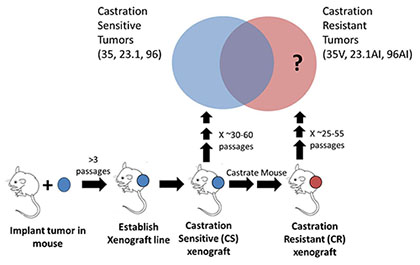


Posted July 8, 2013
Jay Shendure, M.D., Ph.D., University of Washington
Peter Nelson, M.D., Fred Hutchinson Cancer Research Center
 Fundamentally, normal cells transform into cancer cells as a result of underlying changes in the genetic code of the cell. Researchers have attempted to identify and characterize the genetic changes that cause cancer, and new technologies that have reduced the cost of these types of studies provide the potential for even greater strides in prostate cancer genetic research. Funded by a FY09 PCRP Synergistic Idea Development Award, a team of researchers led by Dr. Peter Nelson and Dr. Jay Shendure at the Fred Hutchinson Cancer Research Center and the University of Washington has conducted the first comprehensive assessment of every gene in the genome of advanced, lethal metastatic prostate cancer. While a considerable amount of research into the genome of primary prostate cancer has been done, significantly less is known about the genomes of metastatic prostate cancers.
Fundamentally, normal cells transform into cancer cells as a result of underlying changes in the genetic code of the cell. Researchers have attempted to identify and characterize the genetic changes that cause cancer, and new technologies that have reduced the cost of these types of studies provide the potential for even greater strides in prostate cancer genetic research. Funded by a FY09 PCRP Synergistic Idea Development Award, a team of researchers led by Dr. Peter Nelson and Dr. Jay Shendure at the Fred Hutchinson Cancer Research Center and the University of Washington has conducted the first comprehensive assessment of every gene in the genome of advanced, lethal metastatic prostate cancer. While a considerable amount of research into the genome of primary prostate cancer has been done, significantly less is known about the genomes of metastatic prostate cancers.
By taking advantage both of new emerging technologies and the outstanding resources available at their institutions, such as the University of Washington's Biospecimen Repository for Prostate Cancer Research, Drs. Shendure and Nelson have used a mouse xenograft model to discover a number of potentially key genetic alterations that may contribute to the development of advanced disease. One of the most interesting findings was the discovery of three aggressive "hypermutation" tumor types with 10 times the number of genetic mutations previously found in other advanced prostate cancers. These mutations should provide insight for understanding and identifying lethal prostate cancer, and could be used to develop screening tests for early detection or drug targets to slow or stop cancer growth.
They also found thousands of individual, or "personal," mutations unique to individual tumors, including several mutations that were associated with cancers resistant to testosterone suppression, a common treatment for advanced prostate cancer. This type of information could be extremely valuable in identifying which patients might be more likely to respond to testosterone suppression, preventing unnecessary treatment for other patients. These discoveries are important for facilitating additional insight into the biology of prostate cancer and ultimately the development of more effective therapies.
Kumar, Akash et al. Exome Sequencing Identifies a Spectrum of Mutation Frequencies in Advanced and Lethal Prostate Cancers. Proc Natl Acad Sci U S A. 2011 Oct 11;108 (41):17087-92.

Figure Legend: Approach to identify genes involved in castration resistance. Immuno-compromised mice are seeded with human prostate cancer tumors. Tumors grow and are serially passaged in mice, and are defined as a xenograft line after 3 sequential passages in mice. A subset of these mice is castrated, reducing androgen levels in the mouse and therefore causing the (Castration Sensitive, CS) tumor to regress. After a period of time, an androgen insensitive tumor grows, and after more than three passages in a castrated mouse, the xenograft is called Castration Resistant (CR). We sequenced the exomes of both CR xenografts as well as their CS counterparts to identify genes with mutations unique to CR tumors.














